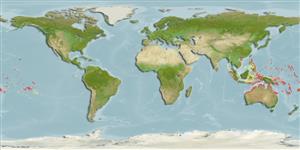>
Gobiiformes (Gobies) >
Gobiidae (Gobies) > Gobiinae
Etymology: Eviota: No etymology given, suggested by Christopher Scharpt: from Latin 'eu' for 'true' and 'iota' for anything very small, in combination 'truly very small' referring to it as being the smallest vertebrate at the time it has benn described by Jenkins (thus, making the suggestion by Scharpt plausible.
Eponymy: Afele was a Samoan boy who collected the holotype from coral heads in Pago Pago. Nothing more was recorded about him. (Ref. 128868), visit book page.
More on authors: Jordan & Seale.
Environment: milieu / climate zone / depth range / distribution range
Ökologie
seewasser riff-verbunden; tiefenbereich 0 - 3 m (Ref. 107299). Tropical; 20°N - 24°S
Pacific Ocean: Ryukyu Islands, Japan; south to Timor Sea and the Great Barrier Reef; east to Oceania and Tuamotus.
Size / Gewicht / Alter
Maturity: Lm ? range ? - ? cm
Max length : 1.8 cm SL Männchen/unbestimmt; (Ref. 1602)
Rückenflossenstacheln (insgesamt) : 7; Rückenflossenweichstrahlen (insgesamt) : 8 - 9; Afterflossenstacheln: 1; Afterflossenweichstrahlen: 6 - 8. This species is distinguished by the following characters: cephalic sensory-canal pore system lacking only the IT pore (pattern 2); branched pectoral-fin rays; dorsal/anal-fin formula is 9/8; the fifth pelvic-fin is ray small or rudimentary (about 10% of 4th pelvic ray); caudal fin has rows of small dark spots set close together on rays, membranes dark; presence of a small dark spot over preural centrum associated with last subcutaneous bar may be present; the scale edges are not dark (Ref. 107299).
Occurs on algal mats of shallow exposed reefs.
Life cycle and mating behavior
Geschlechtsreife | Fortpflanzung | Ablaichen | Eier | Fecundity | Larven
Benthic spawner.
Myers, R.F., 1991. Micronesian reef fishes. Second Ed. Coral Graphics, Barrigada, Guam. 298 p. (Ref. 1602)
IUCN Rote Liste Status (Ref. 130435: Version 2024-1)
Bedrohung für Menschen
Harmless
Nutzung durch Menschen
Tools
Zusatzinformationen
Download XML
Internet Quellen
Estimates based on models
Preferred temperature (Ref.
123201): 24.8 - 28.9, mean 27.5 °C (based on 364 cells).
Phylogenetic diversity index (Ref.
82804): PD
50 = 0.5000 [Uniqueness, from 0.5 = low to 2.0 = high].
Bayesian length-weight: a=0.00692 (0.00284 - 0.01683), b=3.10 (2.92 - 3.28), in cm total length, based on LWR estimates for this Genus-body shape (Ref.
93245).
Trophic level (Ref.
69278): 3.0 ±0.3 se; based on size and trophs of closest relatives
Widerstandsfähigkeit (Ref.
120179): hoch, Verdopplung der Population dauert weniger als 15 Monate. (Preliminary K or Fecundity.).
Fishing Vulnerability (Ref.
59153): Low vulnerability (10 of 100).
Nutrients (Ref.
124155): Calcium = 624 [246, 2,501] mg/100g; Iron = 2.13 [0.77, 5.38] mg/100g; Protein = 17.6 [15.4, 19.6] %; Omega3 = 0.0851 [, ] g/100g; Selenium = 27.4 [5.8, 108.0] μg/100g; VitaminA = 100 [15, 677] μg/100g; Zinc = 6.37 [3.02, 11.93] mg/100g (wet weight);
